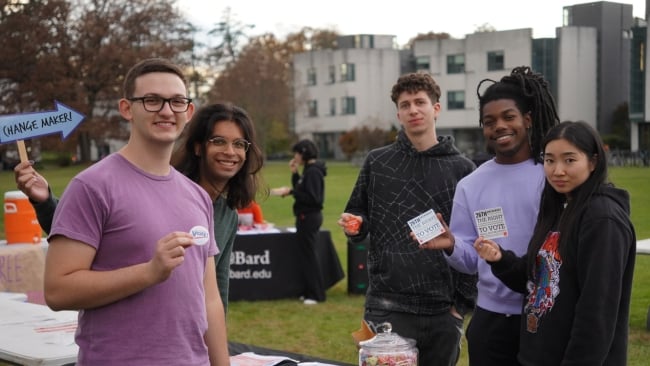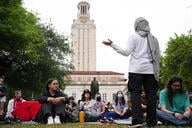You have /5 articles left.
Sign up for a free account or log in.

Members of Election@Bard, a student-led initiative that helps students register to vote, on Bard’s campus during the 2022 election.
Jonathan Asiedu/Bard College
When New York passed a law in April 2022 requiring all colleges that enroll at least 300 registered voters to have a polling place on campus—or at a nearby location selected by administrators—student voting rights activists breathed a sigh of relief.
Voting has historically been difficult for college students in New York. At Vassar College in Dutchess County, the campus was split into three different voting districts until 2022, meaning students were often uncertain about where to vote; simply moving to a new dorm across the street might have required changing their voter registration. Prior to 2020, Bard College students, meanwhile, were required to vote in a nearby church that was cramped and more than a mile from campus—though the college got its own polling place in time for that year’s general election.
The new law promised to make the process easier. College officials hoped to put polling places in campus centers where students already congregated daily, encouraging them to vote even if they weren’t willing to journey off campus. Advocates believed it would boost turnout: Youth voting in New York—as in most of the country—is relatively low, with only 47.8 percent of 18- to 24-year-olds voting in the 2020 general election, compared to 68 percent of the 45-to-64 cohort, which had the highest turnout.
But implementing the law has not gone smoothly, according to Jonathan Becker, a professor of political studies and the director of the Center for Civic Engagement at Bard, who helped facilitate a study into the institutions that have been granted polling places since the law was passed.
Rather than focus on campuses that have at least 300 registered voters, Becker’s study looked at institutions with a minimum of 1,000 student. Among that group, only three institutions had added new polling sites between the November 2022 election and the one the following year, the study found. Meanwhile, one campus lost one: St. Francis College, which moved locations, does not have a polling place at its new home. Over all, 25 percent of the private institutions and 38 percent of the public ones surveyed had polling places.
Now, with only days remaining until the March 15 deadline for the state’s Board of Elections to lock in the polling places for the next election cycle, Becker is urging university presidents to work with their local election boards to implement the law. One of the biggest barriers has simply been awareness, he said.
“It’s very clear that many people, be that university administrators, students, even election boards, are not familiar with the law, at least not in the way they should be,” he said.
The campaign comes at a time when state legislatures nationwide are navigating student voting issues. Republicans in states such as Idaho have worked to prohibit students from using their student ID cards as a form of identification when voting. In Wisconsin, Republican lawmakers recently introduced a bill mandating that the Universities of Wisconsin provide out-of-state students with information on how to vote absentee in their home state’s elections.
Proponents of such measures argue that students shouldn’t have a say in the politics of a place where they spend just nine months a year for four years. Opponents counter that there is no homeownership requirement for voting; communities of renters face no such stipulations. Instead, Democrats accuse Republicans of pushing legislation to restrict student voting in an attempt to prevent an overwhelmingly left-leaning contingent from making an impact.
Implementing the Law
In a Zoom information session with college leaders on Friday, Becker explained the first steps an institution can take to move toward getting a polling site on campus: first they have to identify an appropriate location, ensure it is ADA-compliant and otherwise meets the criteria for a New York polling site. Then they must work with local election boards to figure out how many students are already registered—which can be challenging, depending on how many ZIP codes a college has.
A number of colleges are looking to follow in Bard’s footsteps and establish a polling place on campus. Dave Stanfield, dean of students at Sarah Lawrence College, admits he didn’t have the law on his radar until he received Becker’s message. Now the college is in the nascent stages of working to get a polling site on campus, although the approximately 1,700-student college doesn’t have the 300 registered voters that would require the Board of Elections to follow through, according to an email from Tajian M. Nelson, the Democratic election commissioner for Westchester County, where Sarah Lawrence is located.
Currently, students must vote at a local school that is about a 20-minute walk from campus.
“I knew that if we could get a polling place on campus, not only would that be in line with our educational objectives; it would also be really successful in that we would increase our voting turnout,” Stanfield said.
For the time being, the college is focused on trying to register voters—which institutions of higher education are required to do by federal law. Sarah Lawrence is partnering with Democracy Matters, a student organization dedicated to getting out the vote. Part of the group’s mission is to help students decide whether they want to vote in Westchester County or submit absentee ballots in their home county. The choices they make will help determine whether the college reaches the 300-registrant threshold.
Despite roadblocks, the law has had a positive impact on some campuses. When the Dutchess County Board of Elections dragged its feet on giving Vassar a polling place in the run-up to the 2022 election, a slew of voting rights organizations filed a lawsuit against the county, arguing that the Board of Elections was in violation of the new law. The petition for a polling place on Vassar’s campus was granted within two days.
The lawsuit alleged that the primary opponent of opening a polling place at Vassar was Republican Board of Elections commissioner Erik Haight, who had also resisted Bard’s establishment of an on-campus polling site some years earlier. The plaintiffs also said in a letter that Haight wanted to suppress the youth vote in Dutchess County, which contains four private universities and a community college.
“Without the law, there would be no polling site on Vassar’s campus, ever, because of the local politics. Absolutely,” said Taneisha N. Means, an assistant professor of political science and a plaintiff in the lawsuit. “That is the nightmare for any group trying to disenfranchise a group of people to then place the actual power—the ballot—in close proximity to that group of people.”
Moving in the Right Direction
Pace University, too, has successfully leveraged the new law to move toward securing a polling place on campus, according to Erin Mysogland, assistant director for the university’s Center for Community Action and Research. Much like Vassar’s, Pace’s Manhattan campus is split into multiple districts, which has caused confusion for students—even though the city’s walkability has made it easy for them to travel to their assigned poll site. But the splintered voting has strained the college in other ways; residence life hosts “poll walks” every election, an event that requires significantly more planning and personnel than it would if every student voted at the same location.
Once the law was passed, however, Mysogland quickly began pushing for an on-campus polling place. The institution more than meets the 300-registrant threshold; every year it registers at least 200 students, Mysogland said. The Board of Elections was receptive, and now it looks like a site will be established in the student center by the March 15 deadline, though it is not quite set in stone yet.
“It’s where most student events are, most big lectures,” she said. “For us, our consideration was, this is where students are used to going to events, fun events, events for class, so this helps fold it into their normal day.”
The process has been intensive, involving multiple visits by Board of Elections employees to inspect the space. They tested the Wi-Fi, confirmed the location of restrooms and measured indoor and outdoor spaces to ensure they are large enough and accessible to individuals with disabilities, Mysogland said.
Becker hopes that a few more institutions can establish polling places before the March 15 deadline. This year’s presidential election will likely be of extra interest to students, he noted, making it even more imperative for institutions to provide an easy, accessible place to vote.
“Colleges and universities talk about [how] education is part of developing citizens and democracy. Well, there’s no more fundamental right than the right to vote,” he said. “If colleges and universities remain silent [about] a law providing the opportunity for students to vote more easily, then they’re not fulfilling their mission.”




